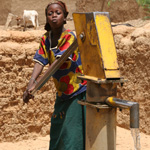
Principles of Sustainability
Chapter 7 - Sustainable Solutions for Water Resources
Part 1 - US and Global Water Resources
 Water is the lifeblood of the Earth. The future of water is the future of life of on the planet. Global demands on the resource including increasing population, pollution, and impacts of climate change portend a water future much different from our water past. Many areas of the globe, such as the communities surviving on glacial melt of the Andes in South America, and the population centers of Western Australia are already coping with this new reality. As the Earth changes, so too will the challenge to humanity. Peak water is a looming threat, or a present reality, for many centers of human population across the world. Change in the hydrological cycle, or consumption beyond rates of recharge, can create a crisis for survival, enhancing the potential for geopolitical conflict. Increasing human demands on the resource will challenge aquatic and terrestrial ecosystems in a system of coupled dynamics that is the hydrological cycle.
Water is the lifeblood of the Earth. The future of water is the future of life of on the planet. Global demands on the resource including increasing population, pollution, and impacts of climate change portend a water future much different from our water past. Many areas of the globe, such as the communities surviving on glacial melt of the Andes in South America, and the population centers of Western Australia are already coping with this new reality. As the Earth changes, so too will the challenge to humanity. Peak water is a looming threat, or a present reality, for many centers of human population across the world. Change in the hydrological cycle, or consumption beyond rates of recharge, can create a crisis for survival, enhancing the potential for geopolitical conflict. Increasing human demands on the resource will challenge aquatic and terrestrial ecosystems in a system of coupled dynamics that is the hydrological cycle.
In addition, the distribution, quality, and quantity of water resources is sensitive to temperature, as well as precipitation changes. Thus, climate change will be a major force in the future of water resources on Earth, shifting supply and changing weather patterns that dominate hydrosphere dynamics. While climate change won’t necessarily reduce the amount of water available, it will change how the water is distributed. For instance, according to a 2011 analysis, the 15% of the world’s population that relies on runoff from glacial melt, may experience a water crisis once the glaciers have all but melted away, while the 1.5 billion people across the globe that draw their water from aquifers may see a surplus from heavier rainfalls due to a changing climate (International Debates, Jan 2011, Vol. 9 Issue 1, p7-10, 4p).
In the totality, our water may be sufficient for now, but the long-term sustainability of this resource is clouded. Freshwater resources are limited in supply and not readily available worldwide; they are easily polluted, and often not found in the areas where the need is greatest. With over one billion people worldwide already without access to clean water, and with an ever-increasing population, demand will most likely grow in the future. Sustainable development, smarter water use, pollution controls, and advancing our water reuse and recycling capabilities will become crucial in determining how we face the challenges ahead. Ultimately, our water future will rise or fall on the efforts we make to sustainably use and manage this most valuable of resources.
Keywords
- hydrologic cycle
- groundwater
- rivers
- streams
- lakes
- reservoirs
- climate change
- water scarcity
- water withdrawls
- water stress
- water cycle
- water reuse
- water recycling
- water consumption
Suggested Reading
- Water in a Changing World, 3rd UN World Water Development Report, 2009. Overview of Key Messages. 10 pp.
Photo credit: Ferdinand Reus, 2008
